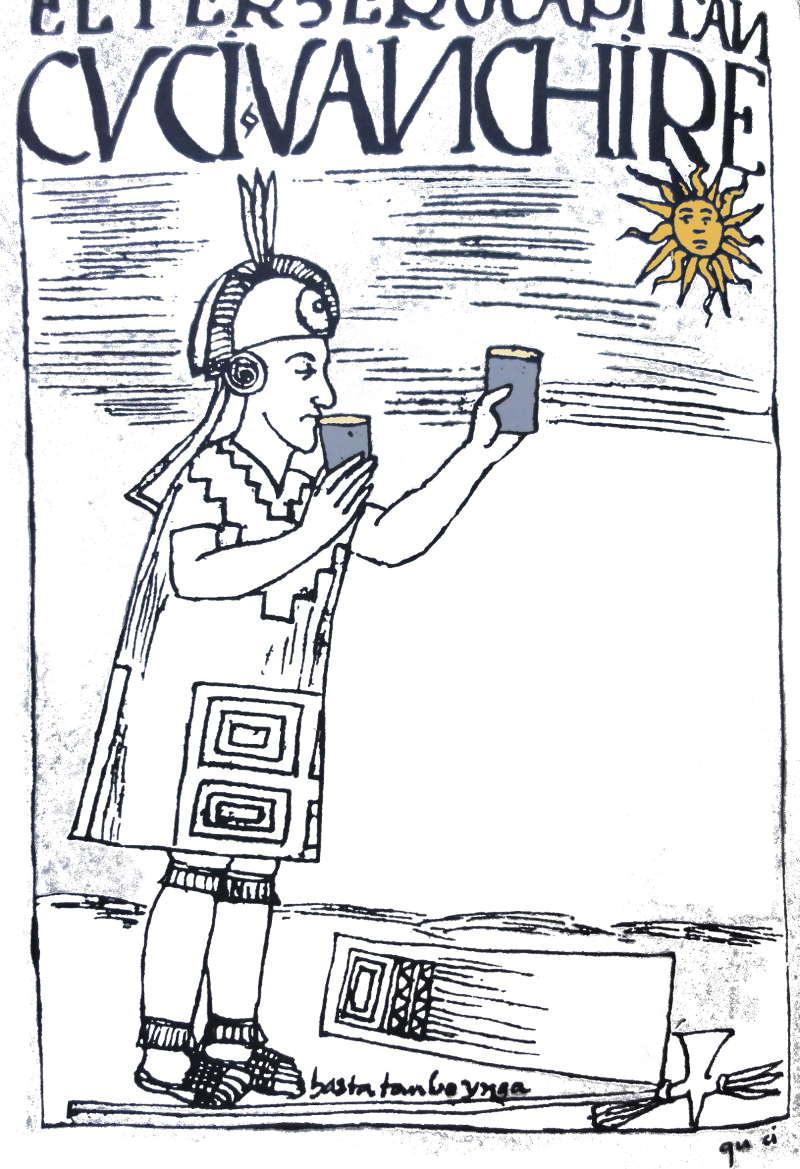The great Inca rituals and the maize beer.
The empire has two faces: that of the Inca emperor and that of the Sun God, a god among the multitude of secondary deities. Throughout the country, land is cultivated for the Inca and other lands for the Sun. To the city of Cuzco and its temples flow the products of the system of collection and collective work at the service of the empire (Mit'a). Cuzco is both a political and religious capital. Fields are cultivated around Cuzco, the harvests of which are dedicated to the temples and the ceremonies that take place there, such as beer offerings[1]. Because maize beer is used as one of the major offerings to the Sun, and also for libations shared with the ancestors, and during the agrarian rites when villagers are sowing or harvesting the grains, mainly corn.
One of the Quechua names for Cuzco, in the time of the Incas, is akha mama, "mother beer" (akha = maize beer in Quechua), for the city is the sacred heart (huaca) of the Inca Empire (Guaman Poma, 1615).
The drinking manners symbolise sharing while re-actualising the social hierarchies. The Inca lord or the local chief distributes the beer to each according to his rank. In the Andes, beer is not sipped from the same pot, contrary to other Amazonian, African or Asian customs appropriate to more egalitarian social structures.
The Inca himself leads the cult of the Sun (Inti Raymi ), the ceremonies for the first sowing and the offerings to the ancestors of the Inca ethnic group. The great festivities organised in Cuzco are large distributions of beer to the people. The Inca is both an intercessor to the deities and the ancestors who guarantee the continuity of the world, and at the same time a great purveyor of beer, the fermented beverage that symbolises the cohesion and prosperity of the empire.
A special maize beer, chewed by virgin girls, is specially brewed for the Inca festivities. The mamakona and aqllakona, "chosen mothers and chosen maidens" are dedicated to the brewing of a sacred beer and the spinning of wool. The excavations of Huánuco Pampa, administrative centre of Chinchaysuy
The mediation of political power materialised by maize beer in Cuzco is reproduced in every regional political centre of the Inca Empire. A local chief is both the one who concentrates power and redistributes it in the form of fermented beverage and food. When the Conquistadors wanted to restrict and then abolish the production of maize beer in order to devote part of the agriculture to wheat and the products they preferred to consume, the Amerindian chiefs complained to the colonial authorities, explaining that without chicha (the generic mestizo name for beer after the Spanish conquest) they lost their authority and prestige :
« It is a great inconvenience, since the main reason that they obey their leaders here, is through the custom that they [the leaders] have to give the people drink ... and if they do not oblige by giving the people drink neither will the people plant their crops for them.» (C. Morris 1979 translation).
[1] D'Altroy Terence, Earle Timothy, Browman David L. & al. 1985, Staple Finance, Wealth Finance, and Storage in the Inka Political Economy, Current Anthropology 26(2), 187-206.
[2] Morris Craig 1979, Maize Beer in the Economics, Politics and Religion of the Inca Empire, in Fermented Beverages and Nutrition (Gastineau, Darby, Turner ed.), 21-34.
[3] Morris Craig 1978, L'étude archéologique de l'échange dans les Andes. In: Annales. Économies, Sociétés, Civilisations. 33e année, 5-6 : 936-947.








